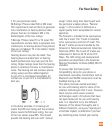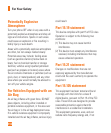
110
For Your Safety
provider or the manufacturer of this phone for
information on hearing aid compatibility. If
you have questions about return or exchange
policies, consult your service provider or phone
retailer.
For information about hearing aids and
digital wireless phones
Wireless Phones and Hearing Aid
Accessibility
http://www.accesswireless.org/
Gallaudet University, RERC
http://tap.gallaudet.edu/Voice/
FCC Hearing Aid Compatibility and Volume
Control
http://www.fcc.gov/cgb/dro/hearing.html
The Hearing Aid Compatibility FCC Order
http://hraunfoss.fcc.gov/edocs_public/
attachmatch/FCC-03-168A1.pdf
Hearing Loss Association of America
[HLAA]
http://hearingloss.org/content/telephones-
and-mobile-devices
Caution:
Avoid potential hearing loss.
Prolonged exposure to loud sounds (including
music) is the most common cause of
preventable hearing loss. Some scientific
research suggests that using portable audio
devices, such as portable music players and
cellular telephones, at high volume settings for
long durations may lead to permanent noise-
induced hearing loss. This includes the use
of headphones (including headsets, earbuds
and Bluetooth® or other wireless devices).
Exposure to very loud sound has also been
associated in some studies with tinnitus (a
ringing in the ear), hypersensitivity to sound
and distorted hearing. Individual susceptibility
to noise-induced hearing loss and other
potential hearing problems varies.
The amount of sound produced by a portable
audio device varies depending on the nature
of the sound, the device, the device settings
and the headphones. You should follow some
commonsense recommendations when using
any portable audio device:
Set the volume in a quiet environment and
select the lowest volume at which you can
hear adequately.


















